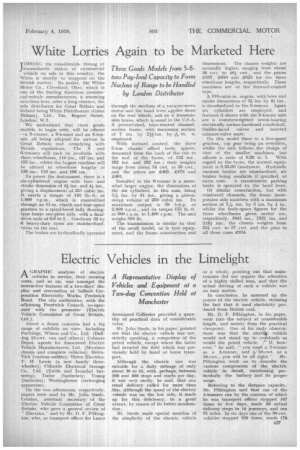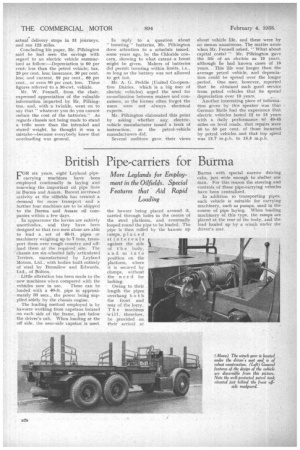Electric Vehicles in the Limelight
Page 15

Page 16

If you've noticed an error in this article please click here to report it so we can fix it.
A Representative Display of Vehicles and Equipment at a Two-day Convention Held at Manchester AGRAPHIC analysis of electric vehicles in service, their running costa, and so on, was amongst the instructive features of a two-days' display and convention at Salford Corporation Electricity Works, Frederick Road. The city authorities, with the adjoining Prestwick Council, co-operated with the promoter f Electric Vehicle Committee of Great Britain, Ltd.), About a dozen concerns had a big range of exhibits on view, including Partridge, Wilson and Co., Lid. (Bulldog 12-cwt. van and others); Colmore Depot, agents for Associated Electric Vehicle Manufacturers, Ltd. (Morrison chassis and complete vehicles); Metro-Vick (various outfits); Victor Eiectrics; T. H. Lewis (a new handy threewheeler); Chloride Electrical Storage Co., Ltd. fExide and Ironclad batterie0 ; Tudor (batteries); Young (batteries); Westinghouse (recharging apparatus).
On the two afternoons, respectively, papers were read by Mr. John Steele, London, assistant secretary of the Electric Vehicle Committee of Great Britain; who .gave a general review of " Electrics," and by Mr. D. F. Filkington, who, as transport officer for Lanes Associated Collieries provided a quantity of practical data of considerable value.
Mr. John Steele, in his paper, pointed out that the electric vehicle was not, strictly speaking, a competitor of the petrol vehicle, except where the latter had invaded the field which was previously held by hand or horse transport.
Although the electric van was suitable for a daily mileage of only about $0 to 35, with, perhaps, between 200 and SOO stops and starts per day, it was very rarely, he said, that any retail delivery called for more than ,this. Although the speed of the electric vehicle was on the low side, it made up for this deficiency, to a great extent, by reason of its better acceleration.•
Mr. Steele made special mention of the simplicity of the electric vehicle as a whole, pointing out that maintenance did not require the attention of a highly skilled man, and that the actual driving of such a vehicle was an easy matter.
In conclusion, he summed up the points of the electric vehicle, stressing the fact that it used electricity produced from British coal.
Mr. D. F. Pilkington, in his paper, went into the subject at considerable length, and mainly from the practical viewpoint. One of his early observations was that the elect'. vehicle would not stand up to ov rloads as would the petrol vehicle, " If, however," he said, " you tr , a 2-tont-ler as a 2-tonner, and a, 50-cwt. as a 50-cwt., you will be all right." Mr. Pilkington went on to describe the various components of the electric vehicle in detail, mentioning particularly the battery and its proper, usage.
Referring to the distance capacity, Mr. Pilkington said that one of the 3-tormers run by the concern of which he was transport officer stopped 167 times in five days, made 50 -actual delivery stops in 14 journeys, and ran 01 miles. In six days One of the 30-cwt. vehicles stopped 329 times, made 178
actual delivery stops in 31 journeys, and ran 123 miles.
Concluding his paper, Mr. Pilkington said he bad seen the savings with regard to an electric vehicle summarized as follow:—Depreciation is 60 per cent:less than the petrol vehicle; tax, 20 per cent, less; insurance, 30 per cent, less; and current, 50 per cent., 60 per cent., or even SO per cent. less. These figures referred to a 30-cwt. vehicle.
Mr. W. Fennell, from the chair, expressed appreciation of the valuable information imparted by Mr. Pilkington, and, with a twinkle, went on to say that " whatever you do you cannot reduce the cost of the batteries." As regards chassis not being made to stand a trifle more than the intended and stated' weight, he thought it was a mistake—because everybody knew that overloading was general.
In reply to a question about " boosting " batteries, Mr. Pilkington drew attention to a schedule issued, some years ago, by the Chloride concern, showing to what extent -a boost might he given. Makers of batteries did permit boosting within limits, i.e., so long as the battery was not allowed to get hot
Mr. A. G. Peddie (United Co-operative Dairies, which is a big user of electric vehicles) urged the need for co-ordination between makers and consumers, as the former often forgot the users were not always electrical experts.
Mr. Pilkington elaborated 'this point by asking whether any, electricvehicle rnanufactuter issued a book of instruction, as the petrol-vehicle manufacturers did:
Several auditors gave their views
about vehicle life, and these were by no means unanimous. The matter arose when Mr. Fennell asked, " What about capital .costs? " Mr. Pilkington gave the fife of an electric as 10 years, although fie had known cases of 1.0 years. . This life was longer than the average petrol vehicle, arid depreciation could be spread over the longer period. One user, however, reported that he obtained such good service from petrol vehicles that he spread depreciation over 10 years, Another interesting piece of information given by this speaker was that German Mails had the experience that electric vehicles lasted 12 to 15 years with a daily performance vi 40-45 miles on level roads, that repairs were 40 to 50 per cent. of those incurred by petrol vehicles and that top speed was 13.7 m.p.h. to 15.5 m.p.h.


































